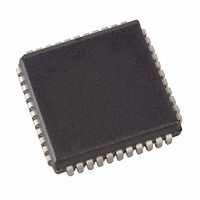AT90S8515-8JI Atmel, AT90S8515-8JI Datasheet - Page 60

AT90S8515-8JI
Manufacturer Part Number
AT90S8515-8JI
Description
IC MCU 8K FLSH 8MHZ IT 44PLCC
Manufacturer
Atmel
Series
AVR® 90Sr
Datasheets
1.AT90S8515-4AC.pdf
(112 pages)
2.AT90S8515-4AC.pdf
(4 pages)
3.AT90S8515-4AC.pdf
(4 pages)
Specifications of AT90S8515-8JI
Core Processor
AVR
Core Size
8-Bit
Speed
8MHz
Connectivity
SPI, UART/USART
Peripherals
Brown-out Detect/Reset, POR, PWM, WDT
Number Of I /o
32
Program Memory Size
8KB (4K x 16)
Program Memory Type
FLASH
Eeprom Size
512 x 8
Ram Size
512 x 8
Voltage - Supply (vcc/vdd)
4 V ~ 6 V
Oscillator Type
Internal
Operating Temperature
-40°C ~ 85°C
Package / Case
44-PLCC
Lead Free Status / RoHS Status
Contains lead / RoHS non-compliant
Data Converters
-
Available stocks
Company
Part Number
Manufacturer
Quantity
Price
Company:
Part Number:
AT90S8515-8JI
Manufacturer:
ATM
Quantity:
4 500
Company:
Part Number:
AT90S8515-8JI
Manufacturer:
ATM
Quantity:
4 500
Part Number:
AT90S8515-8JI
Manufacturer:
ATMEL/爱特梅尔
Quantity:
20 000
Interface to External
SRAM
60
AT90S8515
using the SBI or CBI instruction, ACI will be cleared if it has become set before the
operation.
• Bit 3 – ACIE: Analog Comparator Interrupt Enable
When the ACIE bit is set (one) and the I-bit in the Status Register is set (one), the Ana-
log Comparator interrupt is activated. When cleared (zero), the interrupt is disabled.
• Bit 2 – ACIC: Analog Comparator Input Capture Enable
When set (one), this bit enables the Input Capture function in Timer/Counter1 to be trig-
gered by the Analog Comparator. The comparator output is, in this case, directly
connected to the Input Capture front-end logic, making the comparator utilize the noise
canceler and edge select features of the Timer/Counter1 Input Capture interrupt. When
cleared (zero), no connection between the Analog Comparator and the Input Capture
function is given. To make the comparator trigger the Timer/Counter1 Input Capture
interrupt, the TICIE1 bit in the Timer Interrupt Mask Register (TIMSK) must be set (one).
• Bits 1, 0 – ACIS1, ACIS0: Analog Comparator Interrupt Mode Select
These bits determine which comparator events trigger the Analog Comparator interrupt.
The different settings are shown in Table 18.
Table 18. ACIS1/ACIS0 Settings
Note:
The interface to the SRAM consists of:
Port A: Multiplexed low-order address bus and data bus
Port C: High-order address bus
The ALE pin: Address latch enable
The RD and WR pins: Read and write strobes
The external data SRAM is enabled by setting the SRE (external SRAM enable) bit of
the MCUCR (MCU Control Register) and will override the setting of the Data Direction
Register (DDRA). When the SRE bit is cleared (zero), the external data SRAM is dis-
abled and the normal pin and data direction settings are used. When SRE is cleared
(zero), the address space above the internal SRAM boundary is not mapped into the
internal SRAM, as AVR parts do not have an interface to the external SRAM.
When ALE goes from high to low, there is a valid address on Port A. ALE is low during a
data transfer. RD and WR are active when accessing the external SRAM only.
When the external SRAM is enabled, the ALE signal may have short pulses when
accessing the internal RAM, but the ALE signal is stable when accessing the external
SRAM.
Figure 42 sketches how to connect an external SRAM to the AVR using eight latches
that are transparent when G is high.
ACIS1
0
0
1
1
When changing the ACIS1/ACIS0 bits, the Analog Comparator interrupt must be dis-
abled by clearing its interrupt enable bit in the ACSR register. Otherwise an interrupt can
occur when the bits are changed.
ACIS0
0
1
0
1
Interrupt Mode
Comparator Interrupt on Output Toggle
Reserved
Comparator Interrupt on Falling Output Edge
Comparator Interrupt on Rising Output Edge
0841G–09/01













